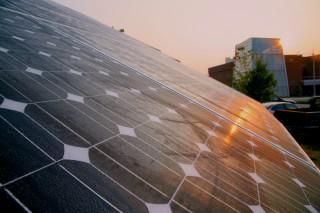Nov 7 2014
When Department of Energy and Oak Ridge National Laboratory researcher Yan Xu talks about “islanding,” or isolating, from the grid, she’s discussing a fundamental benefit of microgrids—small systems powered by renewables and energy storage devices. The benefit is that microgrids can disconnect from larger utility grids and continue to provide power locally.

“If the microgrid is always connected to the main grid, what’s the point?” Xu said. “If something goes wrong with the main grid, like a dramatic drop in voltage, for example, you may want to disconnect.”
Microgrids are designed to not only continue power to local units such as neighborhoods, hospitals or industrial parks but also improve energy efficiency and reduce cost when connected to the main grid. Researchers predict an energy future more like a marketplace in which utility customers with access to solar panels, battery packs, plug-in vehicles and other sources of distributed energy can compare energy prices, switch on the best deals and even sell back unused power to utility companies.
However, before interested consumers can plug into their own energy islands, researchers at facilities such as ORNL’s Distributed Energy Control and Communication (DECC) lab need to develop tools for controlling a reliable, safe and efficient microgrid.
To simulate real scenarios where energy would be used on a microgrid, DECC houses a functional microgrid with a total generation capacity of approximately 250 kilowatts (kW) that seamlessly switches on and off the main grid.
This grid includes an energy storage system that generates 25kW of power and uses 50kW•hours of energy built from second-use electric vehicle batteries, a 50kW- and a 13.5 kW-solar system and two smart inverters that serve as the grid interfaces for the distributed energy emulators. Programmable load banks that mimic equipment consuming energy on the grid can provide sudden large load changes and second-by-second energy profiles.
“A microgrid should run an automated optimization frequently, about every five to 10 minutes,” Xu said.
To optimize grid operations, microgrid generators, power flow controllers, switches and loads must be outfitted with sensors and communication links that can provide real-time information to a central communications control.
“Microgrids are not widely deployed yet. Today, functional microgrids are in the R&D phase, and their communications are not standardized,” Xu said. “We want to standardize microgrid communications and systems so they are compatible with the main grid and each other.”
Now two years into the inception of ORNL’s microgrid project—“Complete System-Level Efficient and Interoperable Solution for Microgrid Integrated Controls,” or CSEISMIC—the microgrid test bed at DECC is functional and employs an algorithm developed at ORNL that directs automatic transition on and off ORNL’s main grid.
Xu said the next year will focus on getting the energy management system (EMS) running. The EMS will drive optimization by allowing microgrid components to fluctuate operation based on parameters such as demand and cost.
“The EMS may, for instance, tell the PVs [solar cells] how much power to generate for the next five to 10 minutes based on the time of day and energy demand,” Xu said.
The CSEISMIC team has long-term goals of partnering with industries to conduct field demonstrations of standardized grid prototypes.
“As soon as microgrids are standardized and easy to integrate into the main grid,” Xu said, “we’ll start seeing them in areas with a high penetration of renewables and high energy prices.”